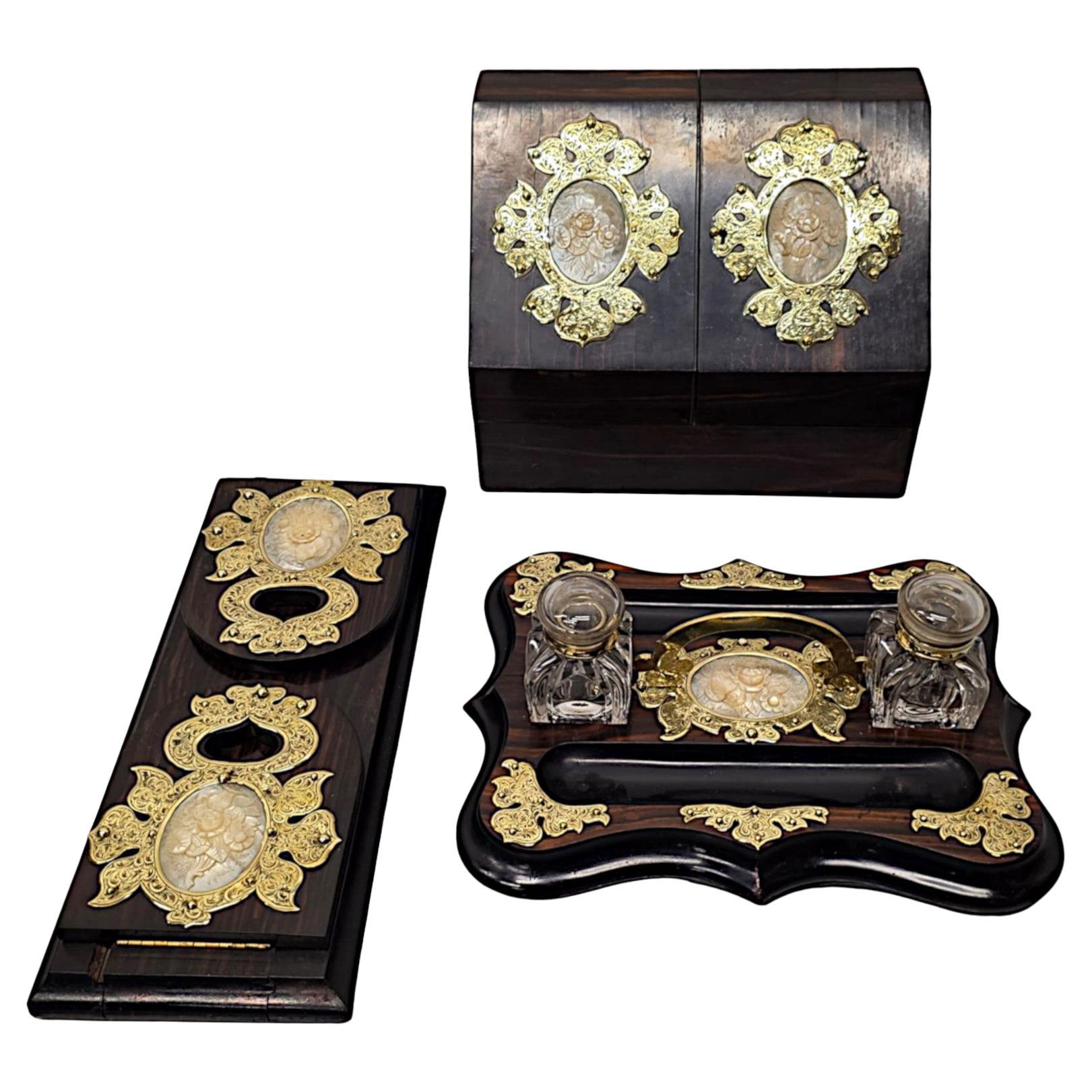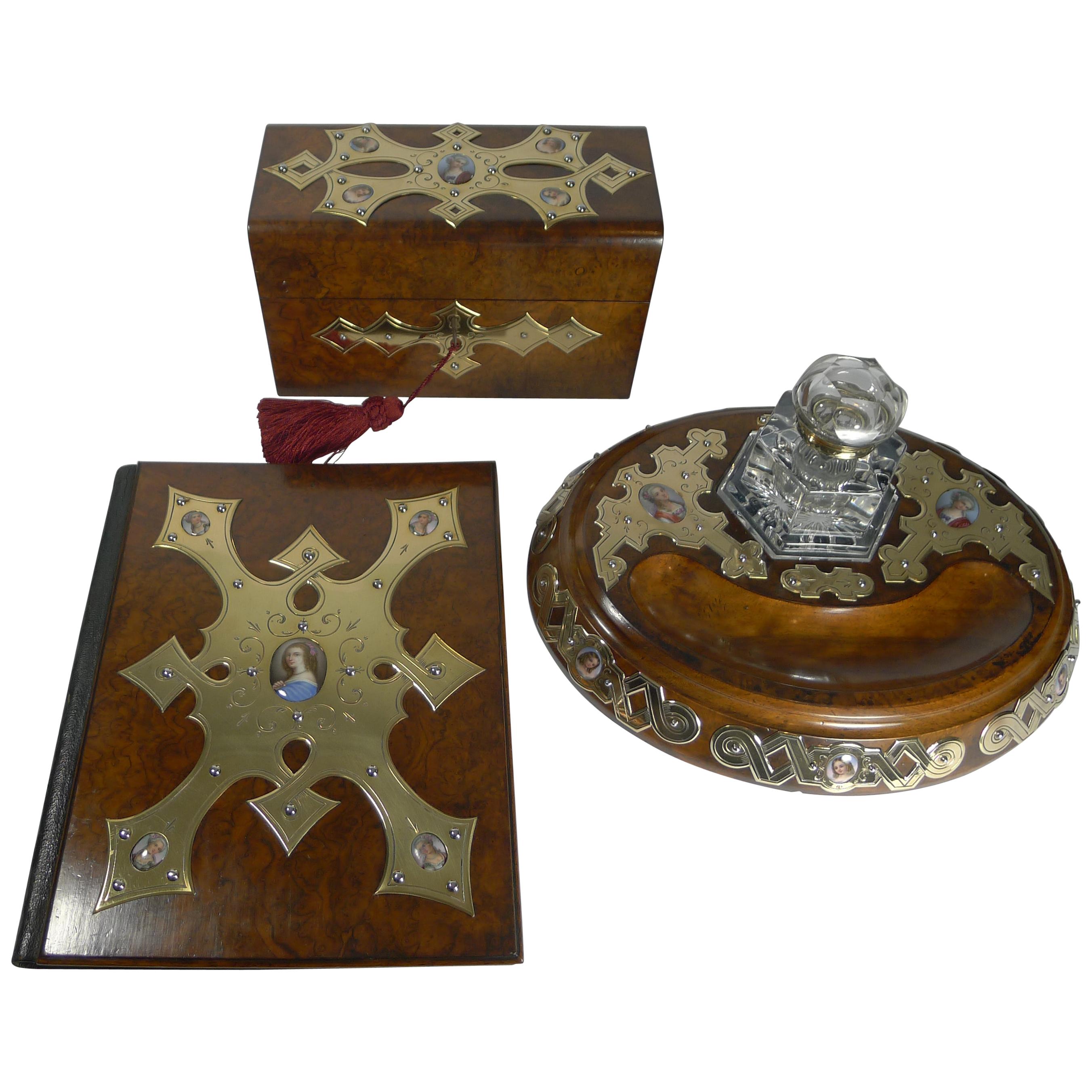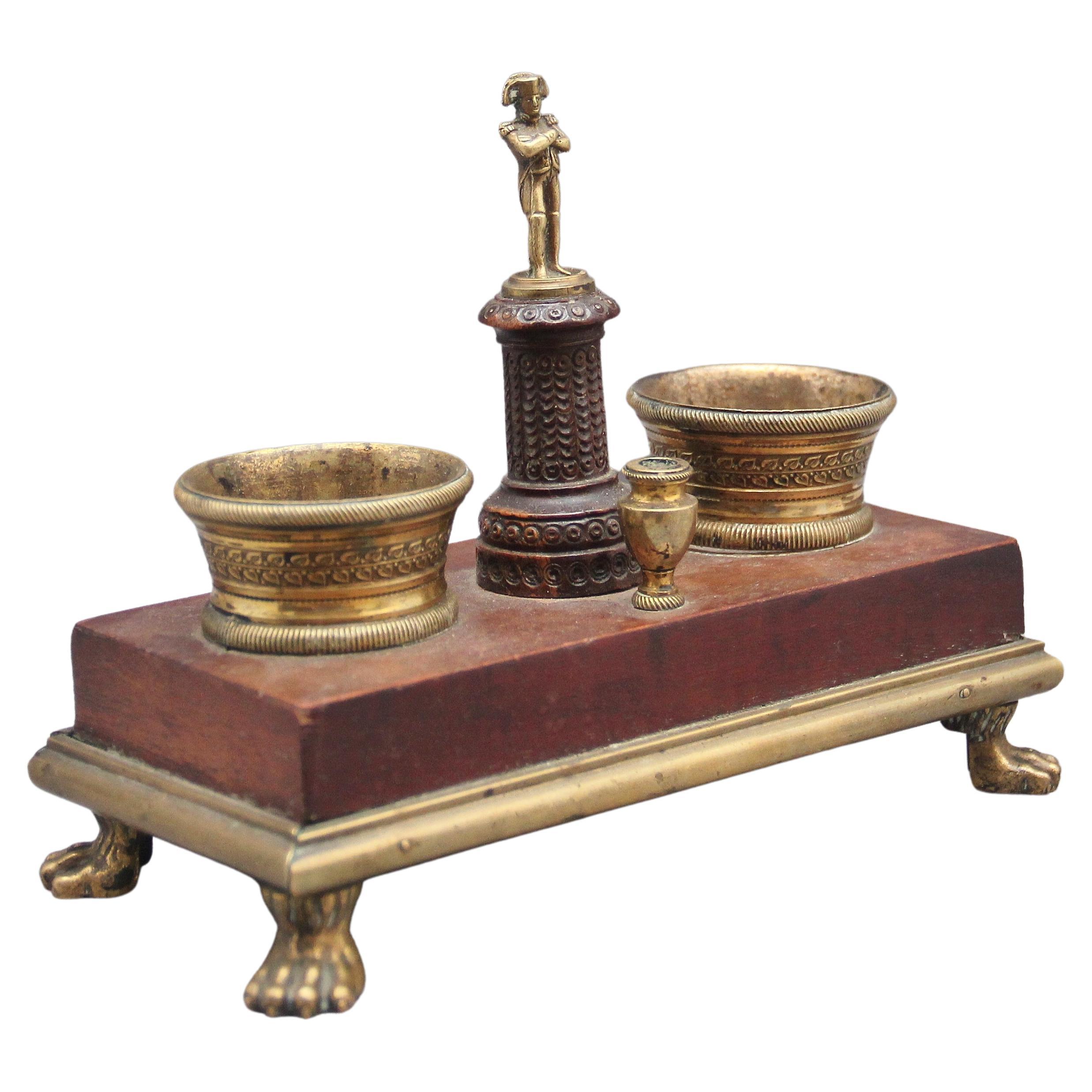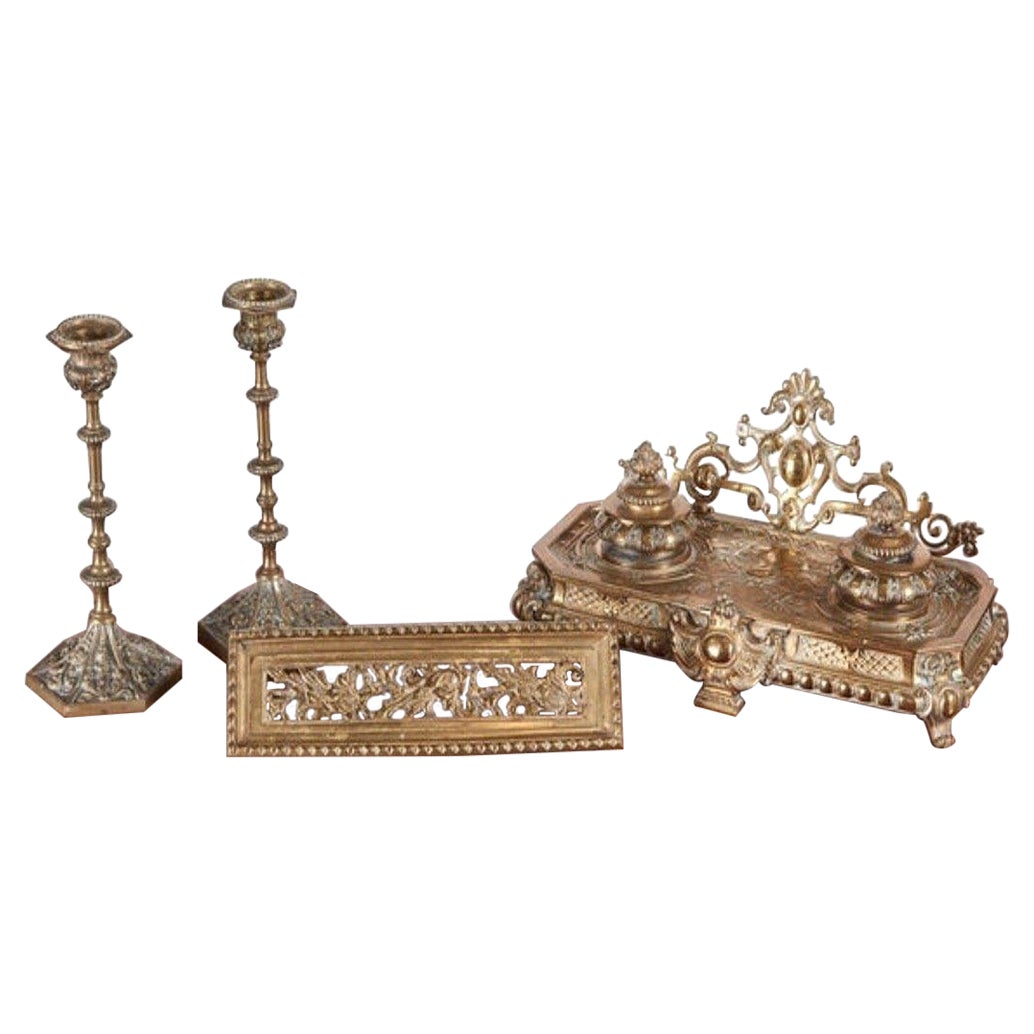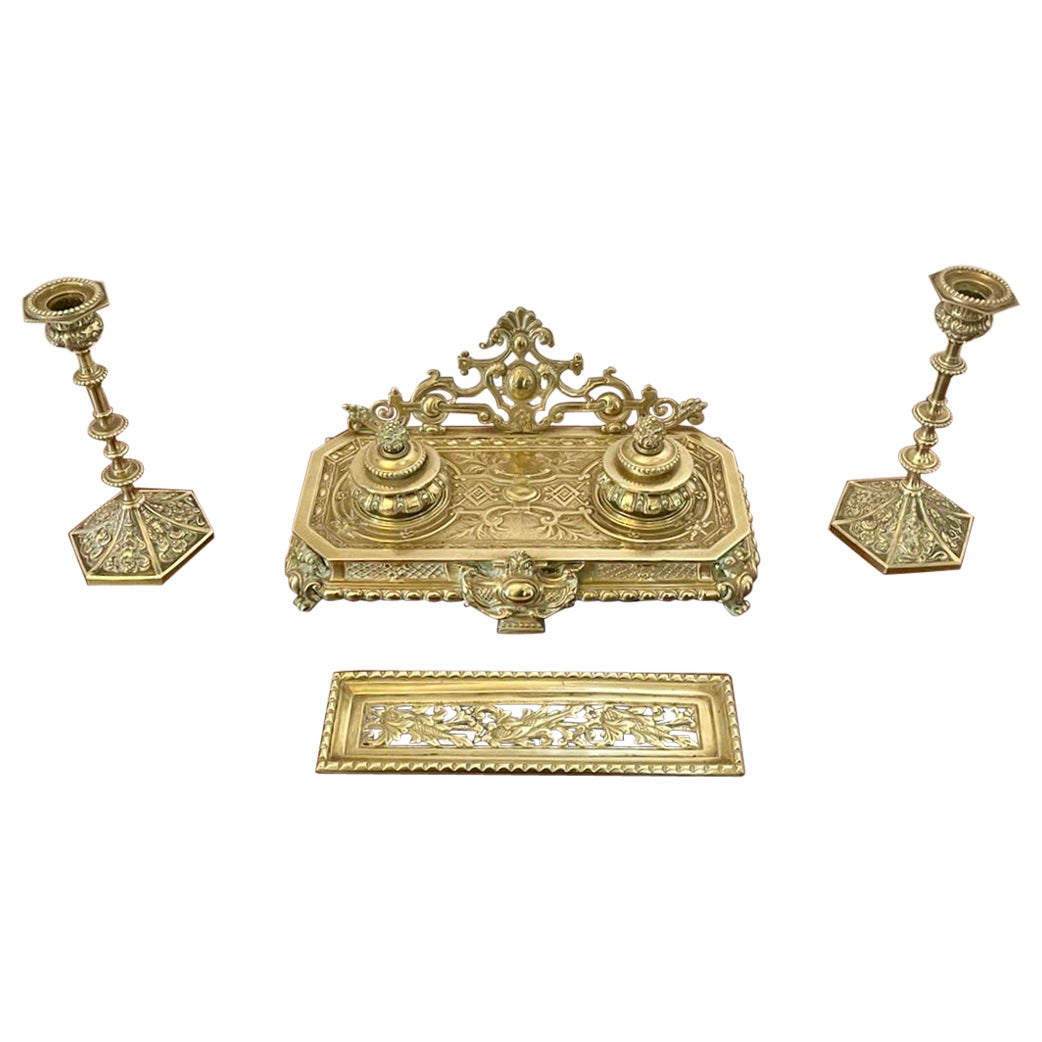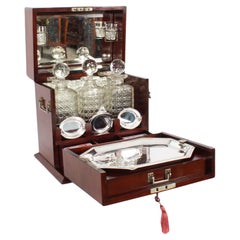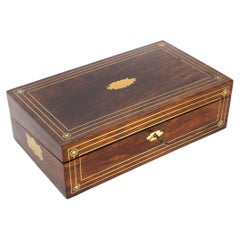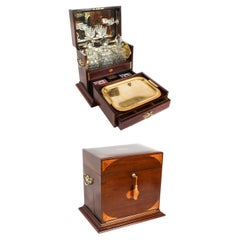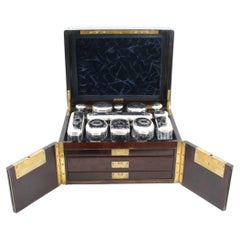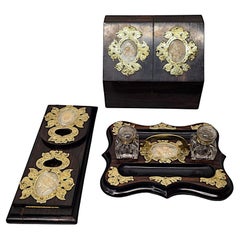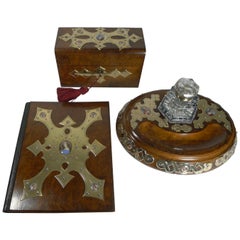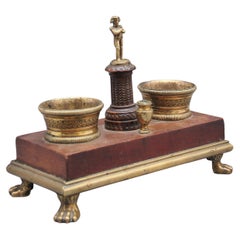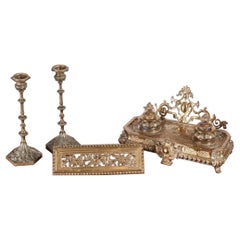Items Similar to Antique English Coromandel & Ormolu Mounted Four Piece Desk Set Mid 19th Century
Want more images or videos?
Request additional images or videos from the seller
1 of 21
Antique English Coromandel & Ormolu Mounted Four Piece Desk Set Mid 19th Century
$2,929.76per set
£2,150per set
€2,533.99per set
CA$4,032.19per set
A$4,494.29per set
CHF 2,358per set
MX$54,882.64per set
NOK 29,857.42per set
SEK 28,219.81per set
DKK 18,912.29per set
About the Item
This is a wonderful and highly decorative antique Victorian ormolu mounted coromandel four piece desk set by the renowned London maker of luxury items, Betjemann & Sons, cira 1860 in date,
The set features gothic style mounts enclosing porcelain medallions decorated with cherubs, comprising a dome topped casket, an adjustable bookrest, a circular cut glass inkwell and a blotter.
There is no mistaking its unique quality and design, which is sure to make it a treasured piece by any discerning collector.
Condition:
In excellent condition having been beautifully restored in our workshops, please see photos for confirmation.
Dimensions in cm:
Height 2 x Width 18 x Depth 41 - Blotter
Dimensions in inches:
Height 1 inch x Width 7 inches x Depth 1 foot, 4 inches - Blotter
Betjemann & Sons
In 1812 George Betjemann started apprenticing as a cabinet maker with his uncle, Gilbert Slater at his premises on Carthusian Street, London. In 1834, George then joined his father-in-law, William Merrick’s cabinet making business on Red Lion Street, Clerkenwell, London. George brought his sons, George William Betjemann and John Betjemann to apprentice with him from 1848. He began his own business at 6 Upper Ashby Street, Clerkenwell, London, and with his two sons having completed their apprenticeships in 1855, expanded to 7 Upper Ashby Street shortly after.
In 1859, George moved into 36 Pentonville Road, London where he continued his business, now called George Betjemann & Sons, alongside his two sons. George William never married but instead was ‘married’ to his work, being a true artist and perfectionist. Their work was on display at the International Exhibition of 1862, and the International Exposition of 1867 in Paris. They took the art of cabinet, box and book slide making to new heights. They specialised in designs for operating the way that different compartments in vanity boxes opened and also the sprung system for book slides.
By 1871, they had expanded their residence to incorporate 38 Pentonville Road and were employing 119 people. Records show that by 1875 a further incorporation of 40 Pentonville Road was undertaken. George died in 1886 at the age of 88 and George William and John ran George Betjemann & Sons in partnership until John’s death in 1893. George William then established a business partnership with John’s sons, John George Betjemann and Ernest Edward Betjemann. Around 1896, John George and Ernest Edward established an offshoot company called Betjemann Brothers, based at 2 Newcastle Place, Clerkenwell, London. This company ran alongside George Betjemann & Sons until they were merged in 1903, following the death of George William. In 1909, they became a limited company, known as George Betjemann & Sons Ltd.
With Ernest’s son John (the future poet Sir John Betjeman) having no interest in carrying on the family business, George Betjemann & Sons Ltd finally wound up in 1939.
Coromandel wood or Calamander wood
is a valuable wood from India, Sri Lanka and South East Asia. It is of a hazel-brown color, with black stripes (or the other way about), very heavy and hard. It is also known as Macassar Ebony or variegated ebony and is closely related to genuine ebony, but is obtained from different species in the same genus; one of these is Diospyros quaesita Thwaites, from Sri Lanka. The name Calamander comes from the local sinhalese name, 'kalu-medhiriya', which means dark chamber; referring to the characteristic ebony black wood.
Coromandel wood has been logged to extinction over the last 2 to 3 hundred years and is no longer available for new work in any quantity. Furniture in coromandel is so expensive and so well looked after that even recycling it is an unlikely source. A substitute, Macassar Ebony, has similar characteristics and to the untrained eye is nearly the same but it lacks the depth of colour seen in genuine Coromandel.
Ormolu - Gilt Bronze (from French 'or moulu', signifying ground or pounded gold) is an 18th-century English term for applying finely ground, high-carat gold in a mercury amalgam to an object of bronze.The mercury is driven off in a kiln leaving behind a gold-coloured veneer known as 'gilt bronze'.
The manufacture of true ormolu employs a process known as mercury-gilding or fire-gilding, in which a solution of nitrate of mercury is applied to a piece of copper, brass, or bronze, followed by the application of an amalgam of gold and mercury. The item was then exposed to extreme heat until the mercury burned off and the gold remained, adhered to the metal object.
Our reference: A3074x
- Creator:George Betjemann & Sons (Maker)
- Dimensions:Height: 0.79 in (2 cm)Width: 7.09 in (18 cm)Depth: 16.15 in (41 cm)
- Sold As:Set of 4
- Style:Victorian (Of the Period)
- Materials and Techniques:
- Place of Origin:
- Period:
- Date of Manufacture:circa 1860
- Condition:
- Seller Location:London, GB
- Reference Number:Seller: A3074x1stDibs: LU950632743482
About the Seller
5.0
Platinum Seller
Premium sellers with a 4.7+ rating and 24-hour response times
Established in 1983
1stDibs seller since 2012
1,375 sales on 1stDibs
Typical response time: <1 hour
Associations
LAPADA - The Association of Arts & Antiques Dealers
- ShippingRetrieving quote...Shipping from: London, United Kingdom
- Return Policy
Authenticity Guarantee
In the unlikely event there’s an issue with an item’s authenticity, contact us within 1 year for a full refund. DetailsMoney-Back Guarantee
If your item is not as described, is damaged in transit, or does not arrive, contact us within 7 days for a full refund. Details24-Hour Cancellation
You have a 24-hour grace period in which to reconsider your purchase, with no questions asked.Vetted Professional Sellers
Our world-class sellers must adhere to strict standards for service and quality, maintaining the integrity of our listings.Price-Match Guarantee
If you find that a seller listed the same item for a lower price elsewhere, we’ll match it.Trusted Global Delivery
Our best-in-class carrier network provides specialized shipping options worldwide, including custom delivery.More From This Seller
View AllAntique Victorian Three Bottle Tantalus & Games Compendium 19th C
Located in London, GB
This is a fabulous antique Victorian games compendium and tantalus, circa 1880 in date.
It consists of three cut crystal liquor bottles with stoppers, a pair of engraved shot glasses, a silver plated tray and a fitted cribbage board...
Category
Antique 1880s Desk Sets
Materials
Crystal, Silver Plate
Antique Regency Campaign Writing Slope Brass Mounts, 19th Century
Located in London, GB
An elegant Regency brass mounted Gonçalo Alves campaign writing slope, circa 1820 in date.
The beautifully polished goncalo alves case has a ...
Category
Antique 1820s Regency Desk Sets
Materials
Wood
Antique Victorian Three Bottle Tantalus & Games Compendium 19th Century
Located in London, GB
This is a fabulous antique Victorian games compendium and tantalus, circa 1880 in date.
It consists of three cut crystal liquor bottles with stoppers with a pair of port glasses, an...
Category
Antique 19th Century Victorian Desk Sets
Materials
Crystal, Gold Plate
Antique Palais Royal French Casket Necessaire Vanity Chest 19th Century
Located in London, GB
This is a fine and well fitted ebonised Gonçalo Alves Palais Royal travel necessaire / vanity chest, by Maison Smal L. Dujat - Palais Royal 7 (Paris), circa 1850 in date.
This sup...
Category
Antique 1850s French Decorative Boxes
Materials
Silver Plate
Antique Coromandel and Brass Mounted Scent Bottle Box, 19th Century
Located in London, GB
This is an antique Victorian Coromandel scent bottle box of domed form with elaborate decorative brass mounts with inset attractive Pietra Dura cabochons, circa 1860 in date.
The domed lid reveals three cut glass bottles with stoppers.
The box has a working lock with key.
Provenance: The Dr. Lawrie Webster Collection of Boxes...
Category
Antique 1860s English Victorian Decorative Boxes
Materials
Brass
Antique Paris Porcelain & Ormolu Mounted 3 Piece Garniture Early 20th Century
Located in London, GB
A beautiful and monumental Paris porcelain ormolu mounted three piece garniture set with hand-painted scenes and delicate gilt decoration, Circa...
Category
Antique Early 1900s French Porcelain
Materials
Ormolu
You May Also Like
19th Century Rare Coromandel Desk Set
Located in Dublin, IE
A very rare 19th Century well figured coromandel desk set of exceptional quality with rich patination and grain, finely hand carved with highly decorat...
Category
Antique 19th Century English Desk Sets
Materials
Brass
Grand French Three-Piece Desk Set, Hand Painted Porcelain Inset, circa 1860
Located in Bath, GB
Wonderful to find a top-notch, highly decorative and most unusual desk set, French in origin dating to around 1860. Made from nutty coloured burl Walnut, all three pieces are mounted with the most wonderful polished brass mounts all inset with fabulous hand painted porcelain plaques.
Our restorer had to remove all the mounts to professionally clean and on doing so found the name of the figure depicted on the plaques, "Ninon De Lenclos" a French Author, Courtesan, Freethinker and Patron of the Arts.
The set is made up of a Stationery box with brass swing handles each side; the box complete with a working tasselled key. The box opens to reveal the wonderful original gilded leather lining with the original paper lining the sides of the dividers. The lock and hinges are beautifully engraved, a true sign of quality.
The next piece is a hefty large oval Walnut Inkstand with a large glass inkwell...
Category
Antique 1860s French Victorian Decorative Boxes
Materials
Brass
$2,997 Sale Price / set
20% Off
Free Shipping
19th Century Ormolu and Mahogany Desk Set
Located in Martlesham, GB
A lovely 19th Century French ormolu and mahogany desk set on ormolu claw feet, there are two ink well holders and a pen holder, in the centre is a carv...
Category
Antique 1820s French Desk Sets
Materials
Ormolu
Antique Quality 19th Century French Cast-Brass Desk Set
Located in Suffolk, GB
Outstanding quality 19th century antique French cast-brass desk set with a very attractive inkstand having twin inkwells and beautiful pierced gallery. It has a rectangular pierced pen tray and a pair of ornate candlesticks...
Category
Antique 19th Century French Desk Sets
Materials
Brass
Magnificent Quality Antique 19th Century French Cast-Brass Desk Set
Located in Suffolk, GB
Outstanding quality 19th century antique French cast-brass desk set with a very attractive inkstand having twin inkwells and a beautiful pierced gallery. It has a rectangular pierced pen tray and a pair of ornate candlesticks...
Category
Antique 19th Century French Desk Sets
Materials
Brass
A Regency tortoiseshell and ivory desk set
Located in Lymington, Hampshire
A Regency tortoiseshell and ivory desk set, of shaped rectangular form with two glass inkwells, an ivory pot and two ivory pen holders above a curved pen tra...
Category
Antique Early 19th Century English Regency Desk Sets
Materials
Ivory, Tortoise Shell
More Ways To Browse
Mid Century Adjustable Desk
Used Law Office Furniture
Black Gold Desk
Exhibition 1862
Apprentice Piece
Vanity 3 Piece
French Ormolu Mounted Desks
Red Antique Desk
Antique Law Office Furniture
Antique Black French Desks
Brass And Glass Midcentury Desk
New England Desk
Accessory Street
Antique Veneer Desks
Dark Brown Antique Desk
Victorian Study Desk English
Desk 38
Coromandel Wood
